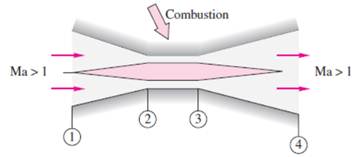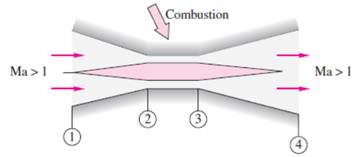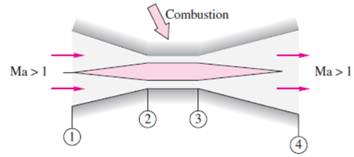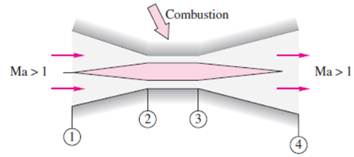
(a)
If the flow will still be supersonic in the throat.
Answer to Problem 9.51P
The Mach number at throat is equal to
The flow is supersonic.
Explanation of Solution
Given information:

Mach number at entrance is equal to,
The altitude is
Inlet area is
The minimum area is
Exit area is
For perfect gas, where
Area change is defined as,
Calculation:
Area change is defined as,
Therefore,
Therefore,
Throat area will be,
For section 2,
According to the table which represents the isentropic flow of a perfect gas,
Therefore by interpolation,
The flow is supersonic.
Conclusion:
The Mach number at throat is equal to
The flow is supersonic.
(b)
To find: the exit Mach number.
Answer to Problem 9.51P
Explanation of Solution
Given information:

Mach number at entrance is equal to,
The altitude is
Inlet area is
The minimum area is
Exit area is
For perfect gas, where
Area change is defined as,
Calculation:
Area change is defined as,
Therefore,
Throat area will be,
At exit,
According to the table which represents the isentropic flow of a perfect gas,
Therefore by interpolation,
Conclusion:
The Mach number at exit is equal to
(c)
To calculate:
The exit velocity.
Answer to Problem 9.51P
Explanation of Solution
Given information:

Mach number at entrance is equal to,
The altitude is
Inlet area is
The minimum area is
Exit area is
The temperature ratio is defined as,
Speed of sound is defined as,
Where,
The Mach number is defined as,
Where,
Calculation:
At altitude of
According to table A.6 which represents the properties of standard atmosphere,
Calculate the stagnation temperature,
Calculate the exit temperature,
Calculate the exit velocity,
Conclusion:
The exit velocity is equal to
(d)
To calculate:
The exit pressure.
Answer to Problem 9.51P
Explanation of Solution
Given information:

Mach number at entrance is equal to,
The altitude is
Inlet area is
The minimum area is
Exit area is
The pressure ratio is defined as,
Where,
Calculation:
At altitude of
According to table A.6 which represents the properties of standard atmosphere,
Calculate the stagnation pressure,
Calculate the exit pressure,
Conclusion:
The exit pressure is equal to
Want to see more full solutions like this?
Chapter 9 Solutions
Fluid Mechanics, 8 Ed
- ! Required information Mechanical engineering, don't use chatgpt. Thanks A 60-kip-in. torque T is applied to each of the cylinders shown. NOTE: This is a multi-part question. Once an answer is submitted, you will be unable to return to this part. 3 in. 4 in. (a) (b) Determine the inner diameter of the 4-in. diameter hollow cylinder shown, for which the maximum stress is the same as in part a. The inner diameter is in.arrow_forwardMechanical engineering, Don't use chatgpt. Strict warning.arrow_forward10:38 PM P 4136 54 A man Homework was due west for and 4km. He then changes directies walks on a bearing south-wes IS How far Point? of 1970 until he of his Starting Port Is he then from his stating What do you think about ... ||| Մ כarrow_forward
- A simply supported T-shaped beam of 6m in length has to be designed to carry an inclined central point load W. Find the max- imum value of this load such that the maximum tensile and com- pression stresses on the beam do not exceed 30 and 60 respectively. N mm² N mm², 90 mm 80 mm Y W 60 mm 30° 10 mm 10 mm Xarrow_forwardProblem 9.5 9.5 A 1080-kg car is parked on a sloped street. The figure shows its wheels and the position of its center of mass. The street is icy, and as a result the coefficient of static friction between the car's tires and the street surface is μs = 0.2. Determine the steepest slope (in degrees relative to the horizontal) at which the car could remain in equilibrium if a. the brakes are applied to both its front and rear wheels; b. the brakes are applied to the front (lower) wheels only. Problem 9.5 1380 mm 532 mm 2370 mmarrow_forwardCan someone explain please with conversionsarrow_forward
- Correct Answer is written below. Detailed and complete fbd only please. I will upvote, thank you. 1: The assembly shown is composed of a rigid plank ABC, supported by hinge at A, spring at B and cable at C.The cable is attached to a frictionless pulley at D and rigidly supported at E. The cable is made of steel with E = 200,000MPa and cross-sectional area of 500 mm2. The details of pulley at D is shown. The pulley is supported by a pin, passingthough the pulley and attached to both cheeks. Note that E is directly above B.Given: H = 3 m; L1 = 2 m; L2 = 4 m; w = 12 kN/m; x:y = 3:4Spring Parameters:Wire diameter = 30 mmMean Radius = 90 mmNumber of turns = 12Modulus of Rigidity = 80 GPaAllowable stresses:Allowable shear stress of Pin at D = 85 MPaAllowable normal stress of cheek at D = 90MPaAllowable bearing stress of cheek at D = 110MPa1. Calculate the reaction of spring Band tension in cable at C.2. Calculate the vertical displacementat C and the required diameter ofpin at D.3.…arrow_forwardCorrect answer and complete fbd only. I will upvote. The compound shaft, composed of steel,aluminum, and bronze segments, carries the two torquesshown in the figure. If TC = 250 lb-ft, determine the maximumshear stress developed in each material (in ksi). The moduliof rigidity for steel, aluminum, and bronze are 12 x 106 psi, 4x 106 psi, and 6 x 106 psi, respectivelyarrow_forwardCan you explain the algebra steps that aren't shown but stated to be there, on how to get this equationarrow_forward
 Elements Of ElectromagneticsMechanical EngineeringISBN:9780190698614Author:Sadiku, Matthew N. O.Publisher:Oxford University Press
Elements Of ElectromagneticsMechanical EngineeringISBN:9780190698614Author:Sadiku, Matthew N. O.Publisher:Oxford University Press Mechanics of Materials (10th Edition)Mechanical EngineeringISBN:9780134319650Author:Russell C. HibbelerPublisher:PEARSON
Mechanics of Materials (10th Edition)Mechanical EngineeringISBN:9780134319650Author:Russell C. HibbelerPublisher:PEARSON Thermodynamics: An Engineering ApproachMechanical EngineeringISBN:9781259822674Author:Yunus A. Cengel Dr., Michael A. BolesPublisher:McGraw-Hill Education
Thermodynamics: An Engineering ApproachMechanical EngineeringISBN:9781259822674Author:Yunus A. Cengel Dr., Michael A. BolesPublisher:McGraw-Hill Education Control Systems EngineeringMechanical EngineeringISBN:9781118170519Author:Norman S. NisePublisher:WILEY
Control Systems EngineeringMechanical EngineeringISBN:9781118170519Author:Norman S. NisePublisher:WILEY Mechanics of Materials (MindTap Course List)Mechanical EngineeringISBN:9781337093347Author:Barry J. Goodno, James M. GerePublisher:Cengage Learning
Mechanics of Materials (MindTap Course List)Mechanical EngineeringISBN:9781337093347Author:Barry J. Goodno, James M. GerePublisher:Cengage Learning Engineering Mechanics: StaticsMechanical EngineeringISBN:9781118807330Author:James L. Meriam, L. G. Kraige, J. N. BoltonPublisher:WILEY
Engineering Mechanics: StaticsMechanical EngineeringISBN:9781118807330Author:James L. Meriam, L. G. Kraige, J. N. BoltonPublisher:WILEY





